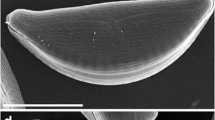Summary
The development of the chloroplasts and the formation of floridean starch grains during carposporegenesis in the coralline algaLithothrix aspergillum Gray, was studied by electron microscopy. Proplastids are first recognized next to the plasmalemma in the youngest cell of the carposporangial filament.
The peripheral thylakoid is the first internal membrane system observed in the proplastid. As the pro-plastid increases in size an irregular branched tubular membrane system, made up of membranous tubules 30–35 nm in diameter, forms in the DNA region of the plastid. This membrane system appears to function as a “pro-lamellar body” as the internal thylakoids are connected to it and appear ot form from it. As thylakoid development continues, the plastids enlarge and may divide, leaving one of the daughter plastids with the “pro-lamellar body”. Thylakoids develop either from the “pro-lamellar body”, or by extension and possibly duplication of existing thylakoids. At about the time that starch grain formation commences the thylakoids have arranged themselves into parallel groups and the single DNA containing region of the plastid has separated into a number of small areas of DNA fibrils destributed throughout the plastid. The earliest signs of phycobilisomes on the outside of the thylakoids are also seen at this stage.
Starch grains develop in the cytoplasm, but in intimate association with the endoplasmic reticulum (ER) which passes on both sides of the developing starch grain, and which appears to be involved in starch grain formation. This close ER-starch grain association, can persist into the mature carpospore. At no stage has any close association between the ER and the chloroplasts been observed.
Similar content being viewed by others
References
Ben-Shaul, Y., J. A. Schiff, andH. T. Epstein, 1964: Studies of chloroplast development inEuglena. VII. Fine structure of the developing plastid. Plant Physiol.39, 231–240.
Borowitzka, M. A., 1976: Some unusual features of the ultrastructure of the chloroplasts of the green algal OrderCaulerpales and their development. Protoplasma89, 129–147.
—, andA. W. D. Larkum, 1974: Chlorplast development in the Caulerpalean algaHalimeda. Protoplasma81, 131–144.
Brown, D. L., andT. E. Weier, 1968: Chloroplast development and ultrastructure in the freshwater red algaBatrachospermum. J. Phycol.4, 199–206.
Calvert, H. E., andC. J. Dawes, 1976: Ontogenetic membrane transitions in plastids of the coenocytic algaCaulerpa (Chlorophyceae). Phycologia15, 37–40.
Chamberlain, A. H. L., andL. V. Evans, 1976: Aspects of spore production in the red algaCeramium. Protoplasma76, 139–159.
Cole, K., andE. Conway, 1975: Phenetic implications of structural features of the perennating phase in the life history ofPorphyra andBangia (Bangiphyceae, Rhodophyta). Phycologia14, 239–245.
Dodge, J. D., 1973: The fine structure of algal cells. London: Academic Press.
Feldmann-Mazoyer, G., 1940: Recherches sur les Ceramiacées de la Mediterranée occidentale. Minerva: Algiers.
Gibbs, S. P., 1962 a: The ultrastructure of the chloroplasts of algae. J. Ultrastruct. Res.7, 418–435.
—, 1962 b: Nuclear envelope-chloroplast relationships in algae. J. Cell Biol.14, 433–444.
Gunning, B. E. S., andM. P. Jagoe, 1967: The prolamellar body. In: Biochemistry of chloroplasts, Vol. II (Goodwin, T. W., ed.), pp. 655–676. London: Academic Press.
Klein, S., J. A. Schiff, andA. W. Holowinsky, 1972: Events surrounding the early development ofEuglena chloroplasts. II. Normal development of fine structure and the consequences of preillumination. Develop. Biol.28, 253–273.
Lichtlé, C., andG. Giraud, 1969: Etude ultrastructurale de la zone apicale du thalle duPolysiphonia elongata (Harv.) Rhodophycée, Floridée. Evolution des Plastes. J. Microscopie8, 867–874.
Mangenot, G., 1923: Sur l'évolution des chromatophores et le chondriome chez les Floridées. C. R. Acad. Sci. (Paris)176, 183–185.
Peyriere, M., 1963: Les Plastes et l'amidon floridéen chez quelques Rhodophycées. C. R. Acad. Sci. (Paris), Sér. D257, 730–732.
Smith-Johannsen, H., andS. P. Gibbs, 1972: Effects of chloramphenicol on chloroplast and mitochondrial ultrastructure inOchromonas danica. J. Cell Biol.52, 598–614.
Spurr, A. R., 1969: A low-viscosity epoxy resin embedding medium for electron microscopy. J. Ultrastruct. Res.26, 31–43.
Stubbe, W., 1971: Origin and continuity of plastids. In: Origin and continuity of cell organelles (Reinert, J., andUrsprung, H., eds.), pp. 65–81. Berlin-Heidelberg-New York: Springer.
Tripodi, G., 1971 a: Some observations on the ultrastructure of the red algaPterocladia capillacea (Gmel.) Born, et Thur. J. submicr. Cytol.3, 63–70.
—, 1971 b: The fine structure of the cystocarp in the red algaPolysiphonia sertularioides (Grat.) J. Ag. J. submicr. Cytol.3, 71–79.
—, 1974: Ultrastructural changes during carpospore formation in the red algaPolysiphonia J. submicr. Cytol.6, 275–286.
—, andDeMasi, 1975: Cytological localization of polysaccharidic molecules in some red algae. J. submicr. Cytol.7, 197–210.
Wetherbee, R., andM. J. Wynne, 1973: The fine structure of the nucleus and nuclear associations of developing carposporangia inPolysiphonia novae-angliae (Rhodophyta). J. Phycol.9, 402–407.
Author information
Authors and Affiliations
Rights and permissions
About this article
Cite this article
Borowitzka, M.A. Plastid development and floridean starch grain formation during carposporogenesis in the coralline red algaLithothrix aspergillum Gray. Protoplasma 95, 217–228 (1978). https://doi.org/10.1007/BF01294452
Received:
Issue Date:
DOI: https://doi.org/10.1007/BF01294452




